Confused about starting a garden? I’ll show you some of the most popular and unique types of gardens out there and what you should keep in mind before getting started.
We’ll explore everything from Vegetable Gardens, where you can grow your own fresh produce, to space-saving Vertical Gardens. And if you’re up for something a bit more challenging, we’ll look at Hydroponic Gardens and the beauty of Flower Gardens.
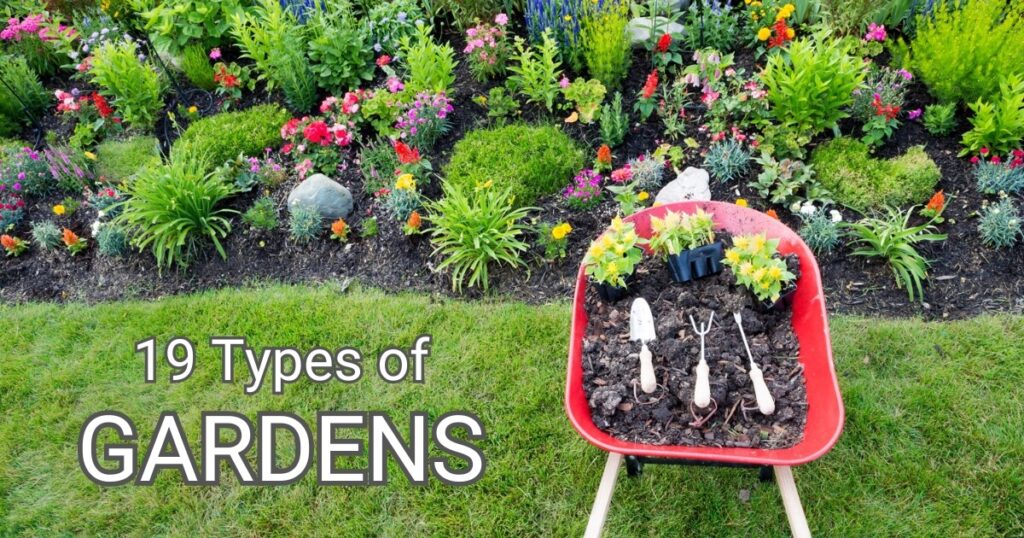
If you’re new to gardening, it’s not just about picking what you want to grow. It’s also about what works best for your available space and time.
But hey, that’s what I’m here for! This guide is designed to ease those worries and help you find a gardening style that fits you perfectly.
Vegetable & Specialty Gardens
Vegetable Gardens
A vegetable garden is like having a farm-to-table setup right at home. These gardens can range from small container gardens to larger raised beds or traditional in-ground rows.
They’re great if you want to enjoy fresh produce and have control over what goes into your food. Keep in mind, though, that vegetables need regular attention and the right seasonal conditions to thrive.
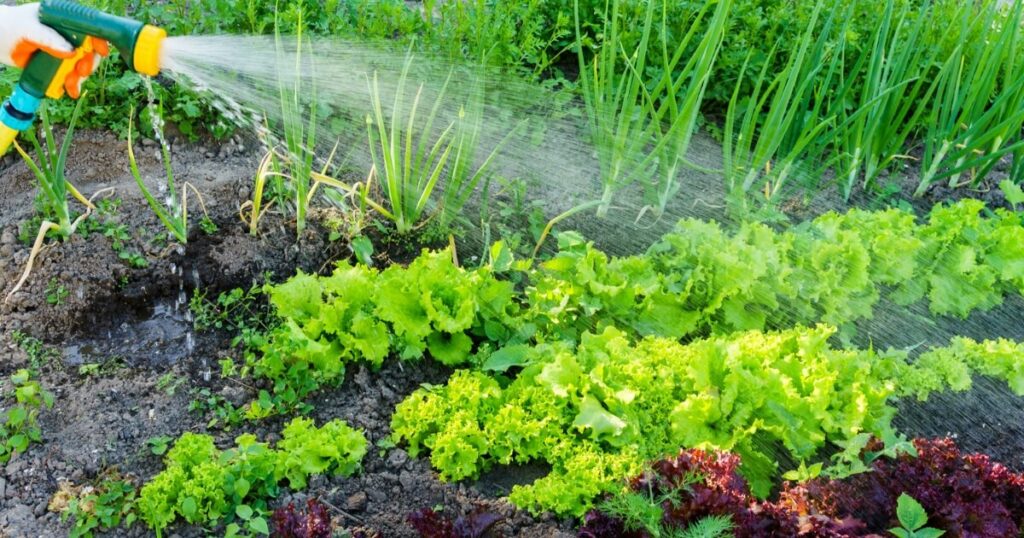
Difficulty: Moderate
Getting Started – Essentials List:
- Space: From containers on a balcony to spacious backyard plots.
- Soil: Rich, well-draining soil with plenty of organic matter.
- Seeds/Seedlings: Start with easy growers like potatoes, lettuce, tomatoes, or radishes.
- Tools: Trowel, hoe, watering can or sprinkler, and a tiller for larger areas.
Start small to manage your workload and learn as you go. A few pots or a small raised bed can yield plenty of veggies without overwhelming you like a large backyard setup would.
Interplanting flowers among your vegetables, known as companion planting, can attract pollinators and beneficial insects that help keep pests at bay. For example, marigolds are not just pretty faces! They attract pests to them instead of your veggies.
Microgreen Gardens
Microgreen gardens are all about growing young, tender greens that pack a nutritional punch. These little guys are harvested just after their first leaves develop. They’re perfect for urban gardeners or anyone with limited space.
Microgreens are a quick crop, often ready to eat in just a couple of weeks, and can add a gourmet touch to meals. The challenge lies in providing consistent light and moisture without overwatering.
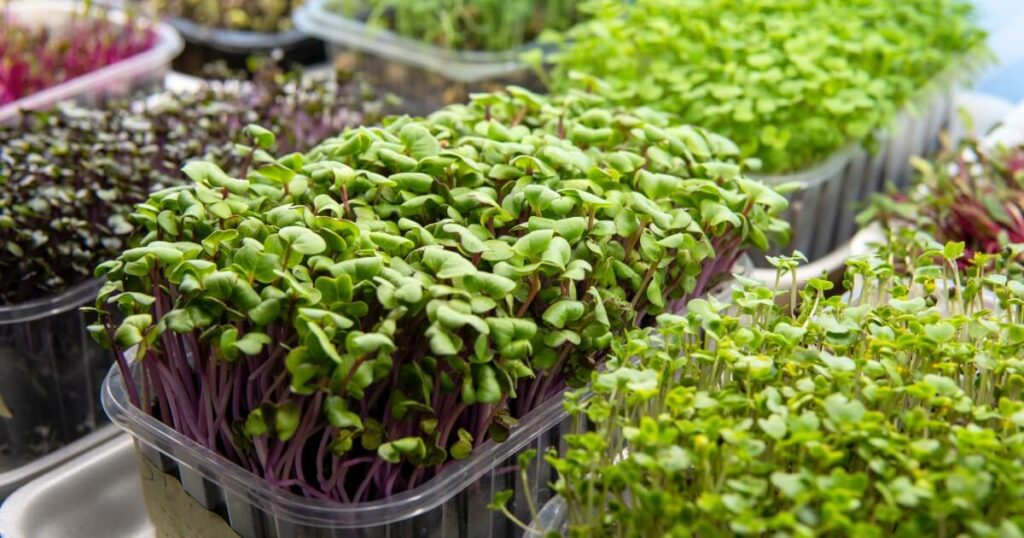
Difficulty: Easy
Getting Started – Essentials List:
- Space: A small tray on a windowsill or under grow lights (I prefer grow lights for consistency).
- Soil: Fine-grained, seed-starting mix that retains moisture well.
- Seeds/Seedlings: Arugula, radish, or pea shoots are great starters.
- Tools: Spray bottle for gentle watering and scissors for harvesting.
Keep your soil moist but never soggy to prevent mold – think of it as giving your microgreens a refreshing mist rather than a downpour.
Be sure to check out my comprehensive guide on “How To Grow Microgreens.” It’s perfect for beginners to help you create and maintain a thriving Microgreen Garden.
Container Gardens
Container gardens are the go-to for those with limited ground space or for adding versatility to any gardening area. You can grow different types of plants in pots, from flowers and herbs to small fruit trees.
This type of garden is ideal for patios, balconies, stairs, and even windowsills.
Containers make it easier to control soil quality and can be moved to optimize sunlight exposure. However, they require more frequent watering than in-ground plants, as pot soil tends to dry out faster.
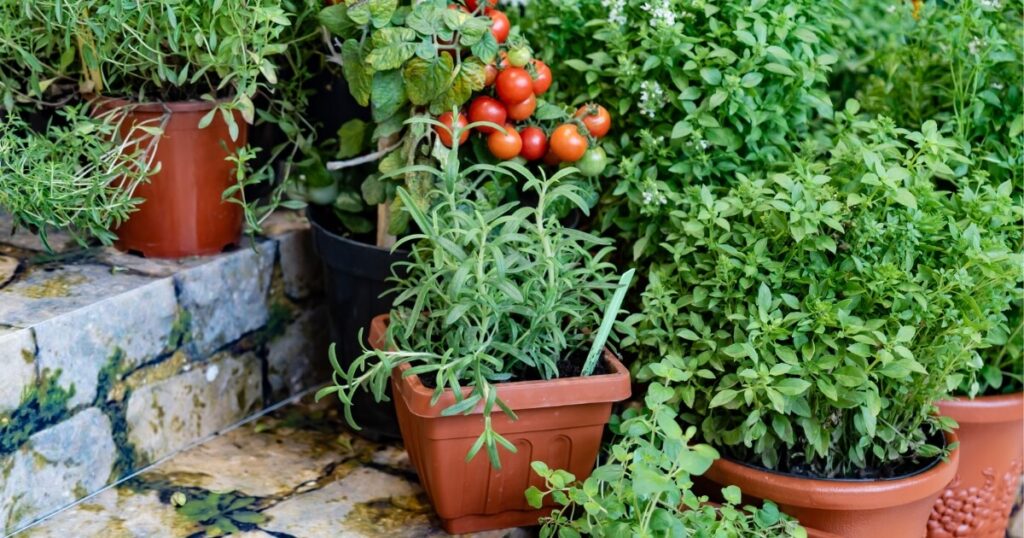
Difficulty: Easy
Getting Started – Essentials List:
- Space: Anywhere that gets sufficient light – from a tiny balcony to a sunny spot indoors.
- Soil: Potting mix designed for container gardening. It’s lighter, sterile, and drains better than regular garden soil.
- Seeds/Seedlings: Herbs like basil and mint, compact veggies like cherry tomatoes, or flowers such as petunias.
- Tools: Pots with drainage holes, a watering can or jug, and a small hand rake or trowel, depending on the size of your container.
Choose the right size container! Too small, you’ll stunt its growth, and too big, you risk waterlogging. Grouping your containers can create a microclimate. This little trick helps retain moisture and protect your plants from wind.
Herb Gardens
A herb garden is a dedicated space for growing aromatic plants used for cooking, keeping pests away, or simply for their pleasant scents. These gardens can be as compact as a few pots on the kitchen windowsill or as expansive as an outdoor plot with various species.
Herbs require less space than vegetables and are quite hardy, making them excellent for beginners. They need plenty of sunlight and a good well-draining soil to flourish. Some perennial herbs can become quite woody and may need regular pruning.
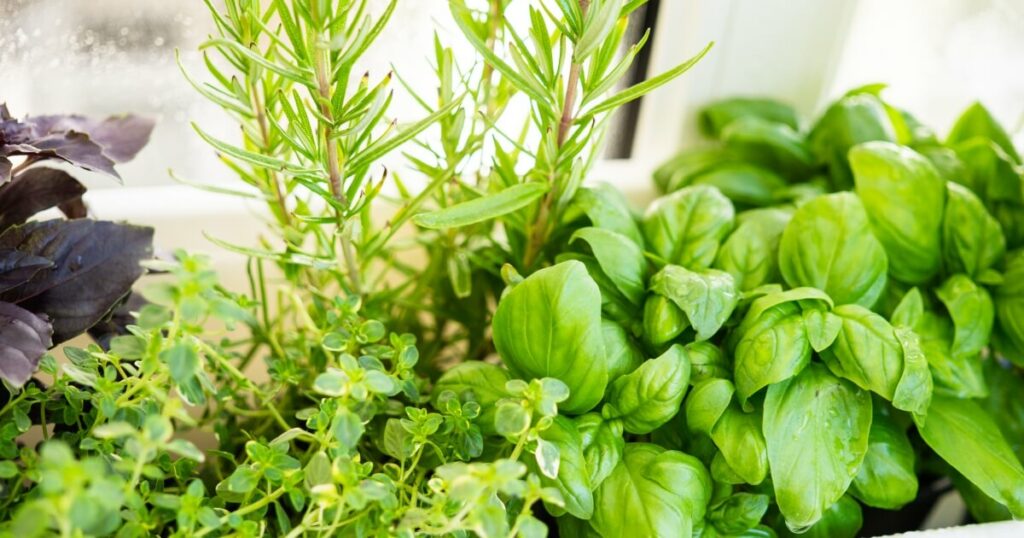
Difficulty: Easy
Getting Started – Essentials List:
- Space: Indoors in pots, outdoors in beds, or even in hanging baskets.
- Soil: Light, airy potting mix that drains well for potted herbs or loamy soil if planted outdoors.
- Seeds/Seedlings: Start with versatile herbs like basil, parsley, or chives.
- Tools: Pruners for harvesting and shaping plants.
Harvest your herbs regularly so that you encourage new growth – snipping off those tasty leaves keeps the plant bushy and productive.
Many herbs like rosemary and lavender are perennials, meaning they’ll come back year after year, giving you more bang for your buck!
Window Box Gardens
Window box gardens are displays of greenery and blooms that sit right outside your window. They’re perfect for adding color to your home’s exterior and can also be enjoyed from the inside.
These gardens are suitable for a variety of plants, including flowers, herbs, and small vegetables. While they’re space-efficient and accessible, they need adequate drainage and do not cause water damage to your home’s siding.
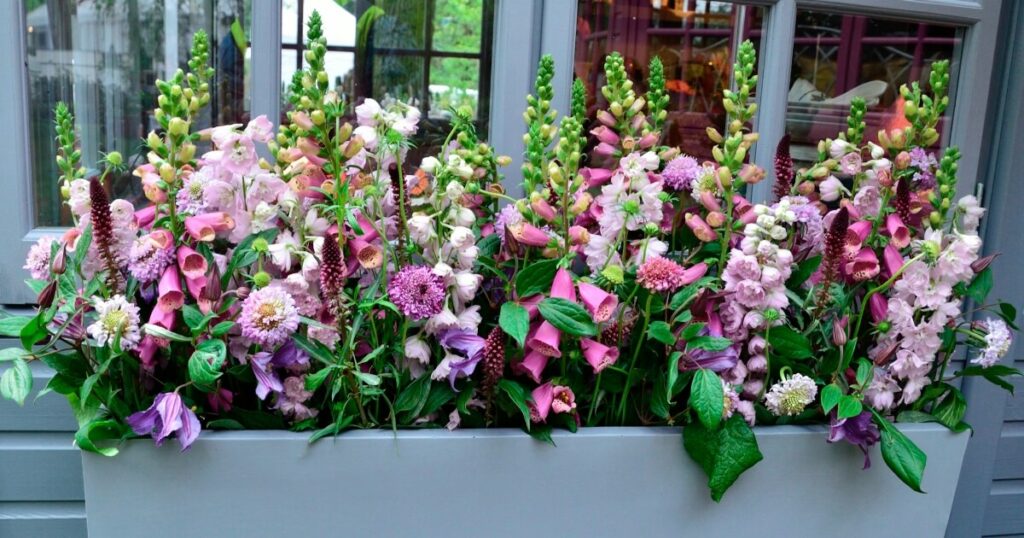
Difficulty: Easy – Moderate
Getting Started – Essentials List:
- Space: A sturdy window ledge or bracket-mounted boxes outside any window.
- Soil: High-quality potting mix to ensure proper drainage and root health.
- Seeds/Seedlings: Petunias, geraniums, or herbs like thyme and oregano work well in these settings.
- Tools: A lightweight watering can with a long spout for easy reach and basic gardening gloves.
Match your plant choices to the amount of sunlight your window box receives – some plants love the sun, while others prefer shadier spots.
Regular feeding is key in window box gardening since the limited soil can deplete nutrients quickly. A slow-release fertilizer can do wonders here.
Hanging Gardens
Hanging gardens are perfect for adding layers of greenery to your outdoor or indoor spaces. These gardens feature plants suspended in baskets or containers, making them ideal for areas where ground space is scarce.
They’re particularly popular for decorative foliage, vibrant flowers, and even some trailing vegetables and herbs.
While they offer an aesthetic boost and can be quite the space-saver, they do require diligent watering as they tend to dry out faster than their grounded counterparts.
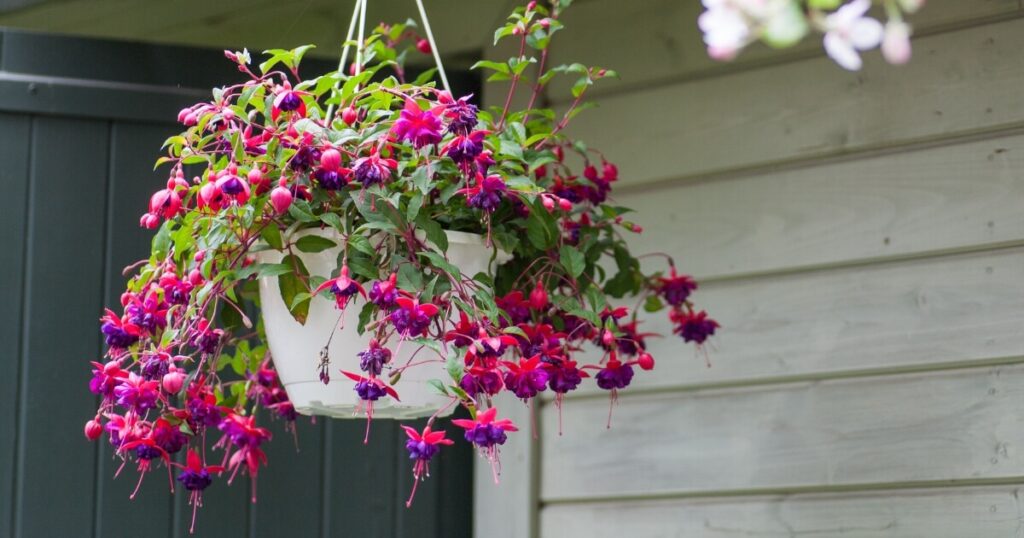
Difficulty: Easy
Getting Started – Essentials List:
- Space: Porches, patios, or any spot with an overhead support strong enough to hold the weight of a hanging plant and out of the wind.
- Soil: Lightweight potting mix that retains moisture and allows excess water to drain.
- Seeds/Seedlings: Trailing plants like ivy or spider plants for foliage. Nasturtiums or lobelia for flowers. Strawberries or cherry tomatoes are good choices for edibles.
- Tools: Hanging baskets or containers, hooks or brackets for mounting, and a long-spout watering can.
Make sure that your hanging baskets are easily accessible to water and care for without too much hassle – nobody wants to play Tarzan!
Rotate your hanging baskets every few days to ensure all sides receive equal light exposure. This helps keep your plants growing evenly rather than leaning towards the sun.
Gardening Techniques
Hydroponic Gardens
Hydroponic gardens are a soil-free gardening solution where plants grow in nutrient-rich water and can use up to 90% less water than regular gardening because the closed system recycles water.
This high-tech option is fantastic for those who want to maximize space and efficiency, as it allows for faster plant growth and can be set up outdoors, but I think it is best indoors to prevent complications.
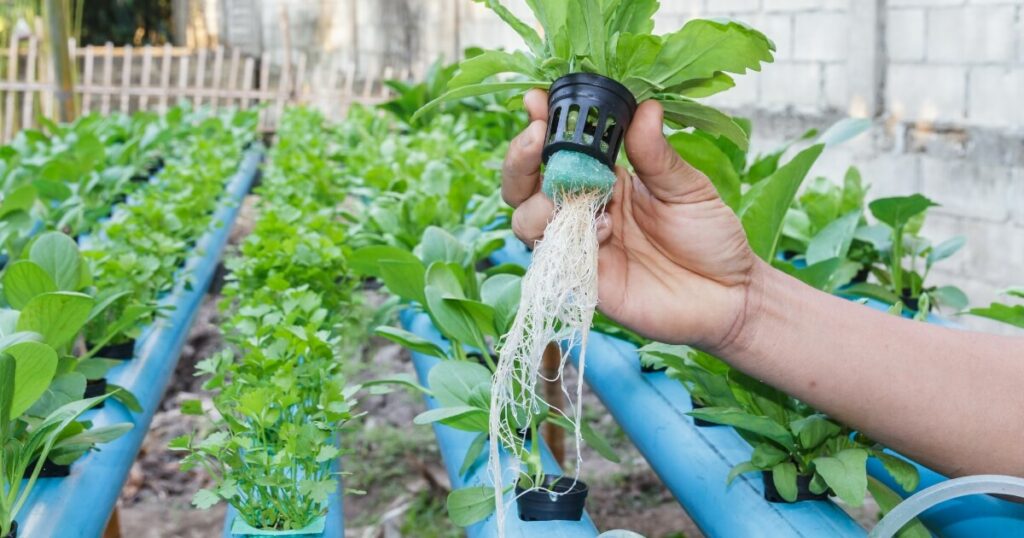
Difficulty: Challenging
Getting Started – Essentials List:
- Space: Indoor shelves or outdoor areas that can accommodate tanks or tubs.
- Soil: None needed – plants grow in a water solution with hydroponic nutrients. Commonly used mediums for root support include rock wool for its moisture retention, along with perlite, vermiculite, and clay pellets, depending on different plant needs.
- Seeds/Seedlings: Leafy greens like lettuce, spinach, herbs, or even strawberries adapt well to hydroponic systems.
- Tools: Hydroponic kit (including pumps, timers, and growing containers), pH test kit, and nutrient solutions.
The lack of soil reduces pests and diseases, but the system requires a bit of a learning curve to manage water pH and nutrient levels.
Monitor your system daily at the start. Keeping an eye on water levels, pH balance, and nutrient mix will help you catch any issues early on.
Upside-Down Gardens
Upside-down gardens are a quirky and space-saving approach to gardening where plants grow out of the bottom of hanging containers. This method is often used for tomatoes, peppers, and other vining plants.
Plants grown upside down don’t have to fight gravity to grow upwards. This means they can put more energy into producing fruit, which is pretty neat!
It’s a conversation starter and can be particularly handy if you have limited space and still want to enjoy homegrown veggies. However, watering can be tricky, as gravity quickly pulls the water away from the roots.
Difficulty: Moderate
Getting Started – Essentials List:
- Space: Balconies, patios, or anywhere with sturdy overhead support.
- Soil: Potting mix that’s rich in organic matter yet light enough to not compact when hanging.
- Seeds/Seedlings: Tomato varieties like ‘Roma’ or ‘Cherry,’ peppers, cucumbers, or herbs.
- Tools: Upside-down planters or DIY containers with holes, hooks for hanging, and a watering can with a long spout.
Water more frequently than you would with traditional containers to ensure your upside-down plants stay hydrated. The trick is not to water too much and have water pouring out on the floor.
Be sure to check out my beginner’s guide to upside-down gardening.
Raised Bed Gardens
Raised bed gardens are like cozy beds for your plants, elevated above ground level and often framed with wood, stone, or concrete. They offer excellent drainage, improved soil conditions, and a barrier against some pests.
Raised beds heat up quickly in spring but can also dry out faster. Mulching is key here because it helps retain moisture and keeps those veggies happy during hot days.
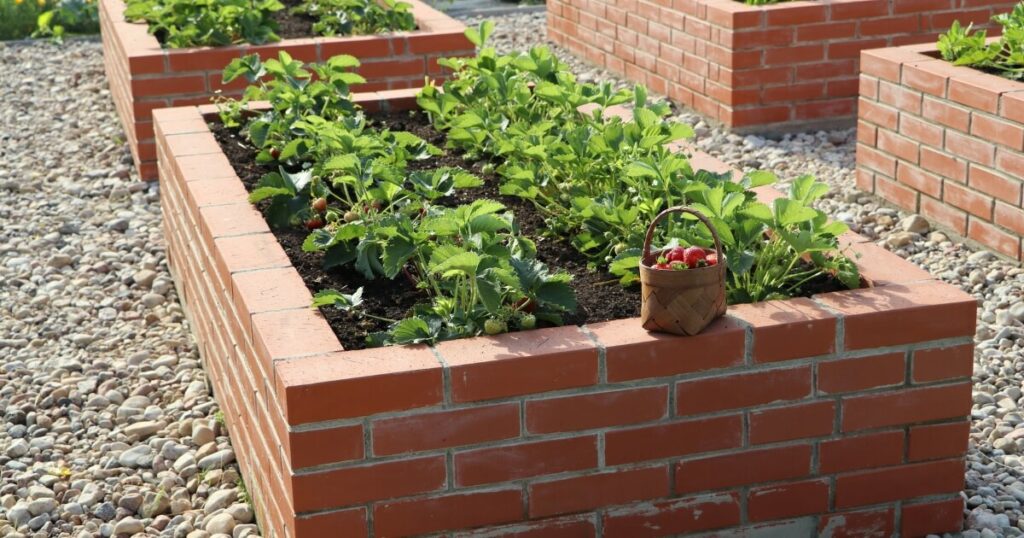
Difficulty: Moderate
Getting Started – Essentials List:
- Space: Any sunny spot in your yard that can fit a raised frame.
- Soil: A mix of topsoil, compost, and other organic materials to fill the bed.
- Seeds/Seedlings: Root vegetables like carrots and beets, leafy plants like kale and spinach, or even flowers for pollinators.
- Tools: Garden fork for mixing soil, spade for planting, and mulch to retain moisture.
They’re also back-friendly since you can control their height and reduce the need to bend over. On the flip side, they can require an initial investment to set up and may need more watering during dry spells.
Plan your raised bed layout with walking space in mind. You want to reach all plants comfortably without stepping into the raised bed and compacting the soil.
Vertical Gardens
Vertical gardens are all about growing upwards instead of outwards, using wall-mounted planters, trellises, or even repurposed shelving.
This approach is perfect for homes with more wall space than ground space. You can grow various plants, including succulents, ferns, and vines.
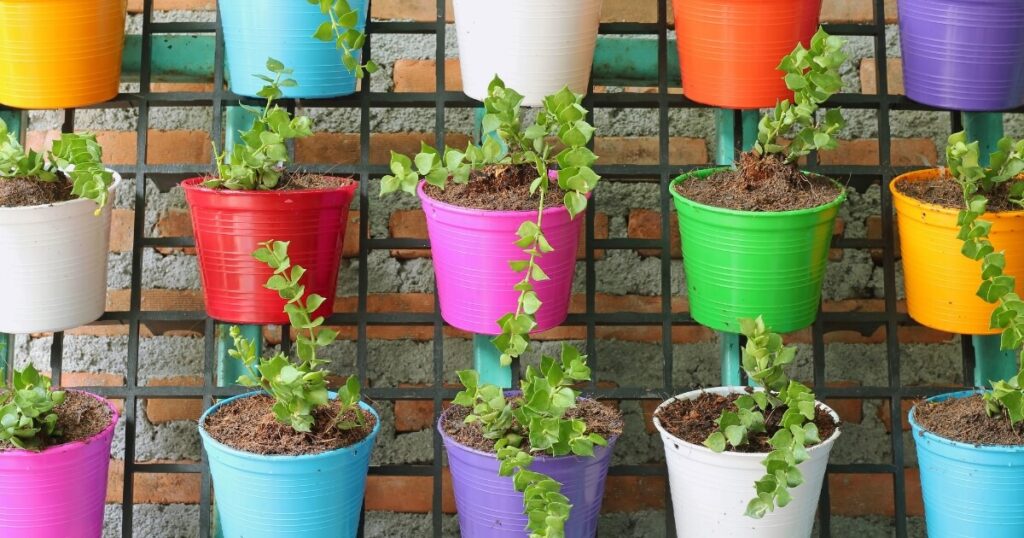
Difficulty: Moderate
Getting Started – Essentials List:
- Space: Any vertical surface that gets adequate light and can support the weight of your garden setup.
- Soil: Use a potting mix appropriate for the types of plants you’re growing, which is often lighter to prevent compaction.
- Seeds/Seedlings: Succulents for dry conditions. Herbs like mint or trailing varieties such as ivy or philodendron.
- Tools: Planters with mounting hardware, a watering system (drip irrigation if possible), and gardening gloves.
The vertical setup can turn a bland wall into a lush tapestry of greenery. But remember, watering can be challenging, and not all plants are suited for vertical living.
Start with a small section to get the hang of it before you cover an entire wall because it’s easier to manage and less daunting.
Natural & Themed Gardens
No-Till Gardens
No-till gardening is a method where the soil is not disturbed by plowing or turning. Instead, you add layers of organic matter on top, such as compost and mulch, which naturally break down to enrich the soil.
This approach promotes a healthy ecosystem for microorganisms and worms that benefit plant growth.
It’s great for reducing erosion and keeping the soil structure intact. The challenge here is that it takes a lot of patience to build up fertile soil without tilling.
Difficulty: Easy
Getting Started – Essentials List:
- Space: Any garden area where you can layer organic materials.
- Soil: Existing soil will improve over time with added compost and mulch.
- Seeds/Seedlings: Hardy plants that can thrive in less-disturbed soil, like perennials or native species.
- Tools: Mulch fork for spreading organic materials, sprinkler, and a broadfork if needed for gentle aeration.
Layer your organic materials thickly to suppress weeds and reduce the need for watering – it’s like tucking your plants into bed with a cozy blanket.
Straw Bale Gardens
Straw bale gardens use straw bales as a growing medium for plants. It’s an innovative method where the bale itself becomes both container and soil.
This technique is perfect for gardeners looking to avoid bending over or dealing with poor soil conditions.
While they offer excellent drainage and a raised growing surface, they may dry out quickly and require consistent moisture.
Difficulty: Moderate
Getting Started – Essentials List:
- Space: Any sunny outdoor area that can support the weight of wet straw bales.
- Soil: None initially, but compost or potting soil may be added to the bales for planting.
- Seeds/Seedlings: Tomatoes, peppers, cucumbers, and other vegetables work well in straw bale gardening.
- Tools: Garden hose for watering, stakes, or trellis for supporting plants.
Straw bales must be conditioned before planting, which involves soaking them and adding fertilizer to start decomposition. You’ll need to condition your straw bales over 10 to 12 days before planting to kickstart the internal composting process that feeds your plants.
Lasagna Gardens
Lasagna gardening, sometimes called sheet mulching, is a no-dig method that involves layering organic materials to create rich, fluffy soil over time. It’s a more specific type of no-till gardening.
Picture making a giant garden lasagna with layers of brown and green materials – brown for carbon-rich elements like dried leaves or shredded newspaper and green for nitrogen-rich materials like grass clippings or food scraps.
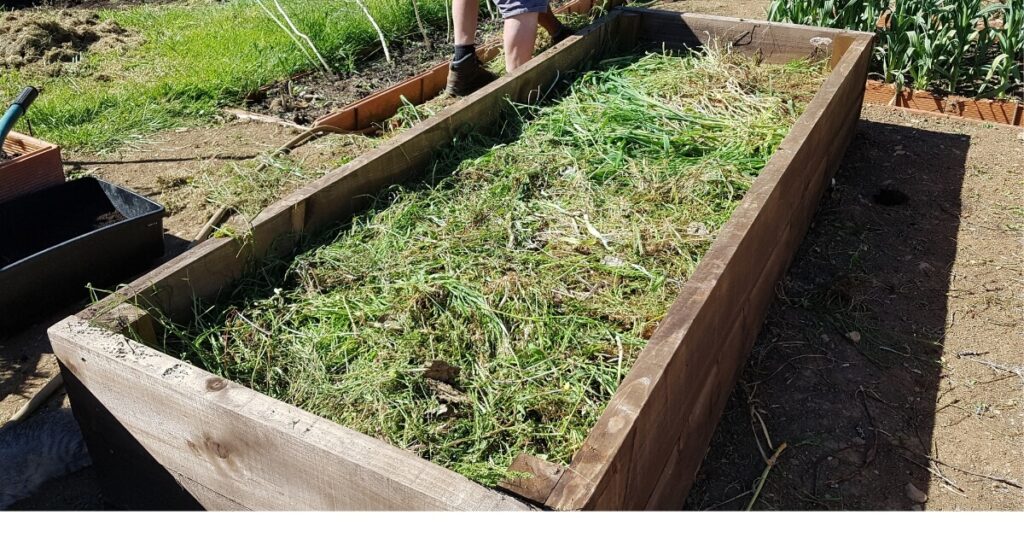
This type of garden is excellent for improving poor soil without tilling and is quite forgiving for beginners. The downside? It can take a season or two before the layers break down into plant-ready soil.
Difficulty: Easy
Getting Started – Essentials List:
- Space: Any area you want to convert into fertile garden space.
- Soil: None to start. The layered materials become the growing medium.
- Seeds/Seedlings: Once established, most plants will thrive. Start with leafy greens or annual flowers.
- Tools: Cardboard or newspaper for the bottom layer, kitchen scraps, and grass clipping materials for subsequent layers, and a hose for watering.
Begin your lasagna garden in the fall. By springtime, earthworms and microbes should have started to turn your “lasagna” into rich soil ready for planting.
You can plant directly into your lasagna garden by adding a little finished compost where you place each seedling. It’s like giving them their mini soil patch with extra nutrients and a good head-start for growth!
Keyhole Gardens
A keyhole garden is a circular raised garden bed with a wedge-shaped cutout for easy access to the center. At the heart of this design is a composting basket where kitchen scraps and yard waste are placed to decompose, thus feeding the surrounding plants.
This type of garden maximizes space and is highly efficient in water usage, making it ideal for arid climates or those looking to conserve water. The construction requires effort, but it’s low-maintenance and can produce abundant yields once established.
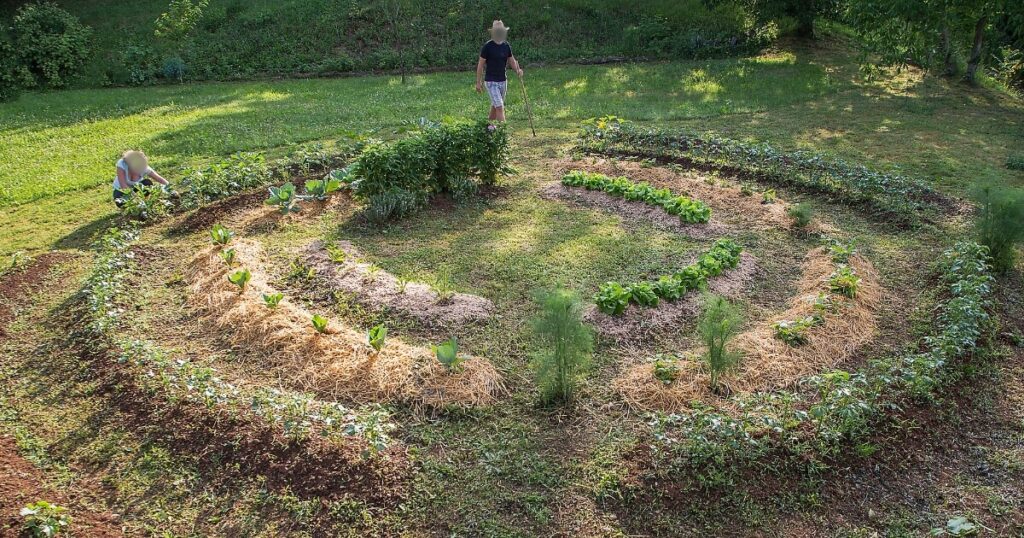
Difficulty: Moderate
Getting Started – Essentials List:
- Space: Requires enough room for a circular bed approximately 6 feet in diameter.
- Soil: A mixture of topsoil, compost, and other organic materials layered over the ground.
- Seeds/Seedlings: Drought-tolerant plants like kale, Swiss chard, or Mediterranean herbs are well-suited for keyhole gardens.
- Tools: Stones or bricks for constructing the walls, wire mesh for the compost basket, and basic gardening tools like a spade.
Build your keyhole garden with materials readily available to you. Recycled bricks or stones can work just as well as new ones.
The central composting basket nourishes your plants and acts as a built-in worm farm. As worms break down organic material, they create nutrient-rich castings that enhance soil fertility.
Decorative & Habitat Gardens
Flower Gardens
Flower gardens allow you to showcase nature’s palette through a variety of blooms and foliage. They range from formal designs with neatly arranged beds to imaginative cottage-style plantings.
Flower gardens can attract pollinators, add curb appeal, and provide cut flowers for your home. They require some planning regarding bloom times, color combinations, and consistent maintenance to keep them looking their best.
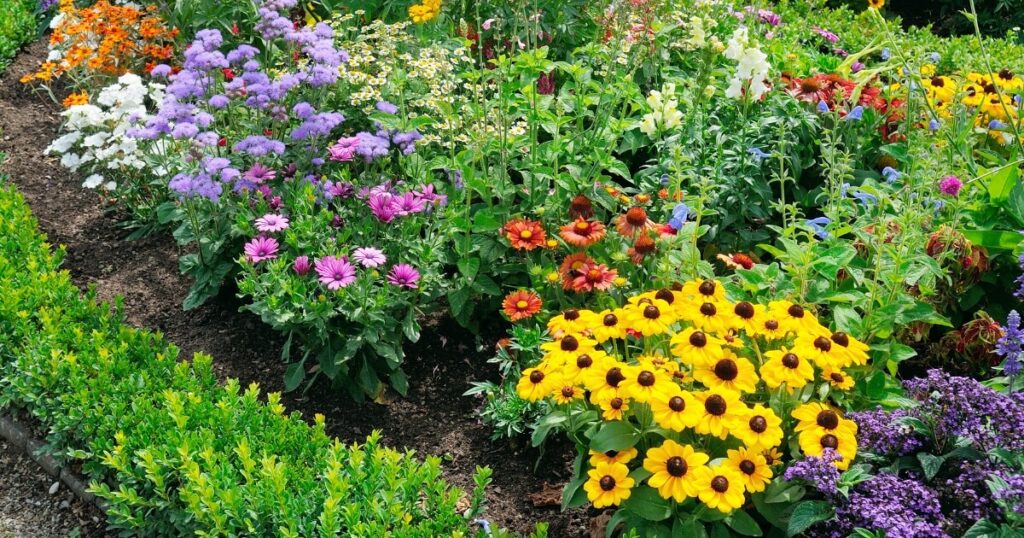
Difficulty: Moderate
Getting Started – Essentials List:
- Space: This can vary from small corner plots and small pots to expansive backyard beds.
- Soil: Depends on the flowers chosen. Many prefer fertile, well-draining soil.
- Seeds/Seedlings: Beginners might opt for hardy annuals like marigolds or perennials like coneflowers.
- Tools: Hand trowel, pruning shears, garden fork, and a watering can or hose.
Choose low-maintenance flowers that are known to thrive in your planting zone because this will set you up for success with less fuss.
Deadheading spent flowers encourages plants to produce more blooms rather than setting seeds. While it takes some extra work, this will keep your garden looking vibrant all season long.
Rock Gardens
Rock or alpine gardens are rugged beauties that mimic high-altitude landscapes. They’re composed of various rocks and boulders with plants nestled in the crevices and pockets between stones.
Rock gardens can be a striking feature in your yard, but setting them up requires some heavy lifting and an eye for design to look natural.
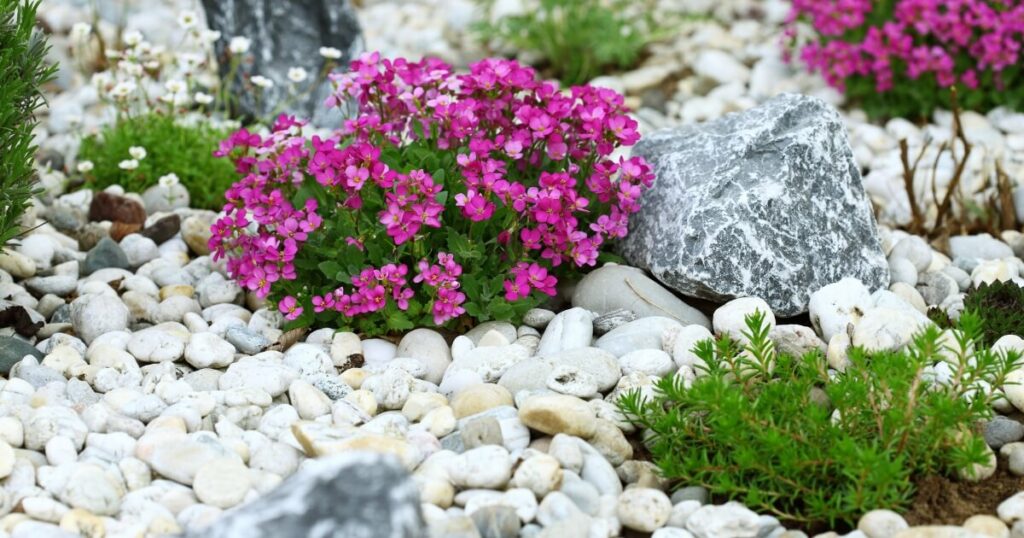
Difficulty: Moderate
Getting Started – Essentials List:
- Space: An area with good drainage, possibly on a slope or an elevated section of your garden.
- Soil: Gritty, sandy soil mix that mimics the drainage of a mountainous habitat.
- Seeds/Seedlings: Alpine plants like sedum or saxifrage. Drought-tolerant species such as lavender, donkey’s tail, or thyme.
- Tools: Rocks of various sizes, landscape fabric to prevent weeds, and basic gardening tools for planting.
Arrange your rocks before you plant. Once you’ve got them just right, tuck your plants into the spaces between. It’s easier than moving heavy stones around later and potentially damaging your plants.
My best tip is if you’re good with computers, take a photo of your rock garden and Photoshop flowers before planting to see how it will look.
Water Gardens
Water gardens are serene retreats that incorporate aquatic plants, fish, and other features like fountains or waterfalls. They can range from small container water gardens to large ponds.
These gardens create a habitat for wildlife and can be a peaceful focal point in your landscape. The sound of running water adds a relaxing ambiance.
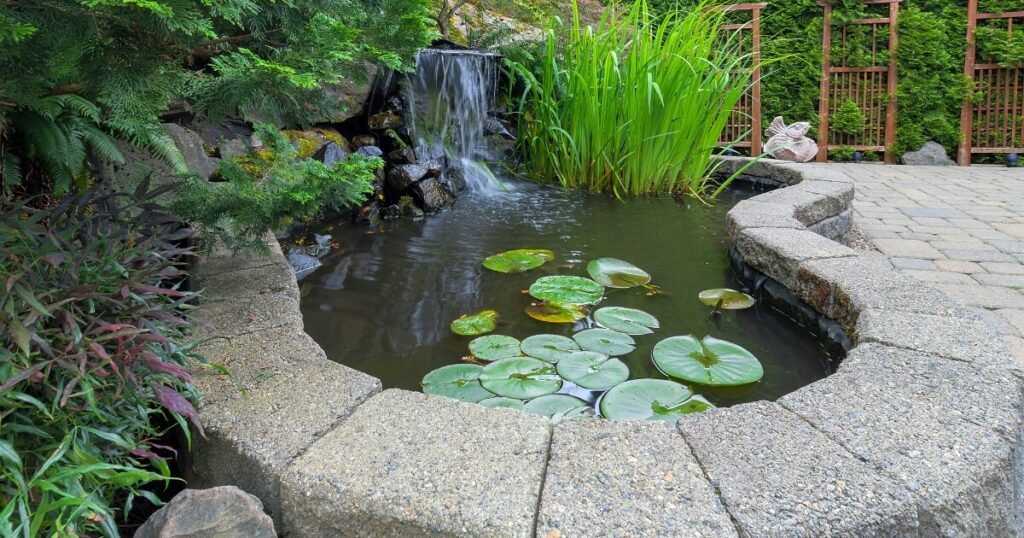
Difficulty: Challenging
Getting Started – Essentials List:
- Space: At least a small patio area for container water gardens and more space for larger ponds.
- Soil: Not needed for the water area, but marginal plants will need aquatic plant soil or baskets filled with suitable substrate.
- Seeds/Seedlings: Water lilies, lotus, and marginal plants like irises or rushes.
- Tools: Pond liner or pre-formed pond basin, pump and filter system, and possibly a skimmer to keep the surface clean.
However, they require upkeep to maintain water clarity and the health of the aquatic ecosystem.
For beginners, I recommend starting with a pre-formed pond kit to simplify the process. It’ll have everything you need to get going without figuring out all the components yourself.
Butterfly Gardens
Butterfly gardens are magical spaces designed to attract and support butterflies throughout their life cycle. These gardens are planted with a mix of host plants for caterpillars and nectar-rich flowers for adult butterflies.
The goal is to provide a habitat that includes food sources, shelter, and water.
While butterfly gardens can be great for your local ecosystem, they require some research to choose the right plants for your area’s native butterfly species.
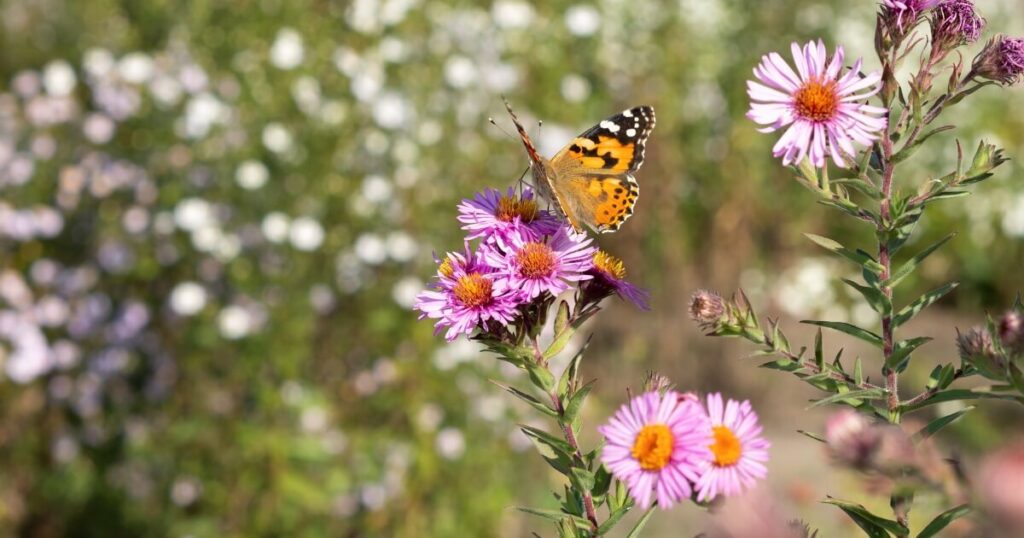
Difficulty: Easy
Getting Started – Essentials List:
- Space: Any sunny spot in your yard or even a balcony with room for pots.
- Soil: Well-draining soil rich in organic matter.
- Seeds/Seedlings: Milkweed for monarchs, dill or fennel for swallowtails, and nectar plants like coneflowers or zinnias.
- Tools: Gardening gloves, trowel, watering can, and possibly a birdbath or shallow dish for water.
Plant in clusters rather than single plants to create a more appealing target for butterflies – it’s like setting up a buffet rather than just a snack bar.
Butterflies need sun to warm their wings for flight, so place your garden in an area that gets plenty of sunlight in the morning. And a water source will help them quench their thirst.
Bee Gardens
Bee gardens are buzzing with activity, designed to attract and nourish our vital pollinator friends, the bees. These gardens are filled with a variety of flowering plants that provide nectar and pollen throughout the growing season.
They’re beneficial for bee populations and bring life and beauty to your space. While creating a bee-friendly garden is rewarding, choosing plants that bloom at different times is important to provide a constant food source and avoid using pesticides that can harm bees.
Of course, if you or anyone living nearby is allergic to bees, it’s better to choose one of the other gardening options instead.
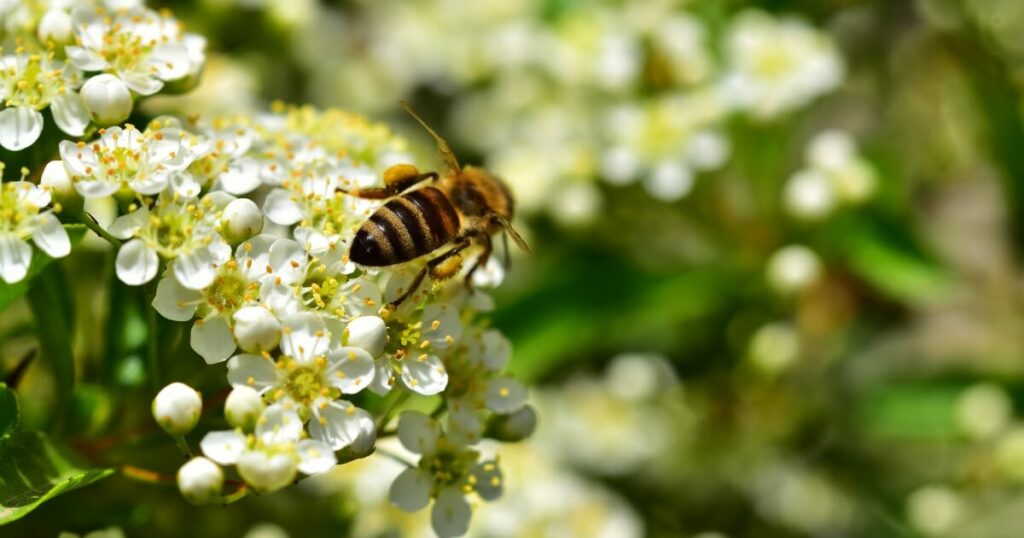
Difficulty: Easy
Getting Started – Essentials List:
- Space: Any sunny area in your garden or even smaller spaces like balconies with flowering pots.
- Soil: Well-drained soil enriched with compost or other organic matter.
- Seeds/Seedlings: Early bloomers like crocus, year-round favorites like lavender, and late bloomers such as goldenrod.
- Tools: Spade, watering can, gardening gloves, and mulch to help conserve water and suppress weeds.
Provide a shallow water source for bees to drink from. A small dish with pebbles or marbles partially filled with water will do the trick. Keep it out of the sun to avoid excess evaporation.
Bees have good color vision, so planting flowers in shades of blue, purple, white, and yellow can help attract more bees to your garden.